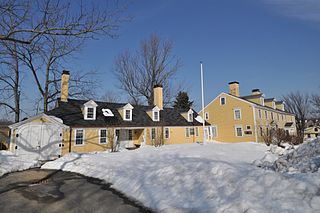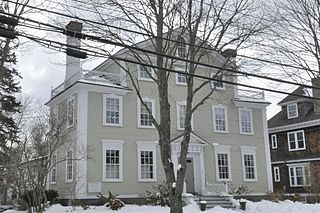 W
WExeter is a town in Rockingham County, New Hampshire, United States. The population was 14,306 at the 2010 census and an estimated 15,317 in 2018. Exeter was the county seat until 1997, when county offices were moved to neighboring Brentwood. Home to the Phillips Exeter Academy, a private university-preparatory school, Exeter is situated where the Exeter River feeds the tidal Squamscott River.
 W
WThe American Independence Museum is a historic house museum located in Exeter, New Hampshire. Its 1-acre (0.40 ha) campus includes two buildings: the Ladd-Gilman House, a registered National Historic Landmark built in 1721 by Nathaniel Ladd, and the Folsom Tavern, listed on the New Hampshire State Register of Historic Places and built in 1775 by Colonel Samuel Folsom. The museum was opened in 1991 after a rare copy of the Declaration of Independence known as a Dunlap Broadside was found in the Ladd-Gilman house, 200 years after its arrival in Exeter. It is the centerpiece of the museum’s collection. The museum’s mission is “Connecting America’s Revolutionary past with the present.”
 W
WThe Congregational Church in Exeter was gathered in 1638 by the Rev. John Wheelwright following his expulsion from the Massachusetts Bay Colony. The current congregation is a merger of the former First Parish and Second Parish of Exeter. Second Parish split from First Parish in the 1700s during the Great Awakening over theological differences. The two congregations then reunited in 1920.
 W
WThe Dudley House, also known as the Perry-Dudley House, is a historic house at 14 Front Street in Exeter, New Hampshire. Built about 1805, it is a prominent local example of Federal architecture, further notable for its occupation by two of the town's leading 19th-century doctors. The house was listed on the National Register of Historic Places in 1971. It now houses professional offices.
 W
WExeter High School is a public high school in Exeter, New Hampshire, in the United States. It serves students in grades 9 through 12 who reside in the towns of Exeter, Stratham, Kensington, Newfields, Brentwood, and East Kingston, New Hampshire. Exeter High School is ranked 9th within New Hampshire. Students have the opportunity to take Advanced Placement® course work and exams. The AP® participation rate at Exeter High School is 36 percent. The student body makeup is 50 percent male and 50 percent female, and the total minority enrollment is 6 percent. Exeter High School is the only high school in the Exeter Region Coop School District. According to state test scores, 55% of students are at least proficient in math and 81% in reading.
 W
WThe Exeter incident or Incident at Exeter was a highly publicized UFO sighting that occurred on September 3, 1965, approximately 5 miles (8 km) south of Exeter, New Hampshire, in the neighboring town of Kensington. Although several separate sightings had been made in the area by numerous witnesses in the weeks leading up to the specific incident, it was the September 3 sighting which eventually became by far the most famous, involving a local teenager and two police officers. The November/December 2011 edition of Skeptical Inquirer offers an explanation of the incident, based on details reported by the eyewitnesses.
 W
WThe Exeter Inn is an inn in Exeter, New Hampshire, United States. Located on Front Street on the campus of Phillips Exeter Academy, the Georgian style complex was built in 1932 and mirrors the school's architectural motif. Guests, which include many parents of Academy students, enjoy its walking distance proximity to historic downtown Exeter.
 W
WExeter station is an Amtrak train station located in Exeter, New Hampshire. The station has one low side platform with an accessible high section serving the single track of the Pan Am Railways Freight Main Line. On average, 230 passengers board or detrain daily, making it the busiest stop in New Hampshire.
 W
WThe Exeter Waterfront Commercial Historic District encompasses the historic commercial and residential waterfront areas of Exeter, New Hampshire. The district extends along the north side of Water Street, roughly from Main Street to Front Street, and then along both sides of Water and High streets to the latter's junction with Portsmouth Street. It also includes properties on Chestnut Street on the north side of the Squamscott River. This area was where the early settlement of Exeter took place in 1638, and soon developed as a shipbuilding center. The district was listed on the National Register of Historic Places in 1980. It was enlarged in 1986 to include the mill complex of the Exeter Manufacturing Company on Chestnut Street.
 W
WThe Front Street Historic District in Exeter, New Hampshire, encompasses a portion of the town's historic center. The district extends from Swasey Pavilion, at the junction of Front and Water streets, southwesterly along Front Street to Gale Park, about five blocks. Front Street is one of Exeter's oldest roads, and is lined with a series of 18th and 19th-century civic, religious, and residential structures, many of which are well preserved. The district was listed on the National Register of Historic Places (NRHP) in 1973.
 W
WThe Gilman Garrison House is a historic house museum at 12 Water Street in Exeter, New Hampshire. Built in 1709, it is a rare surviving example of a First Period garrison house, built with a number of clearly defense-related features. It is owned by Historic New England, which operates the home as a house museum, and was listed on the National Register of Historic Places in 1976.
 W
WThe Maj. John Gilman House is a historic house at 25 Cass Street in Exeter, New Hampshire, United States. Built in 1738, it is a well-preserved example of a Georgian gambrel-roof house, further notable for its association with the locally prominent Gilman family. It was listed on the National Register of Historic Places in 1988.
 W
WThe Ladd-Gilman House, also known as Cincinnati Memorial Hall, is a historic house at 1 Governors Lane in Exeter, New Hampshire, United States. The home was built about 1721 by Nathaniel Ladd as one of the state's first brick houses, and was subsequently clapboarded three decades later. The home was purchased in 1747 by Daniel Gilman, a prominent Exeter merchant. It served as the state treasury during the American Revolutionary War when two members of the Gilman family, Col. Nicholas Gilman and his son John Taylor Gilman, later the state's governor, served as treasurers of the state. Also born in the house was Nicholas Gilman, Jr., a signer of the United States Constitution and U.S. senator from New Hampshire.
 W
WThe Moses-Kent House is a historic house at 1 Pine Street in Exeter, New Hampshire. Built in 1868 for a prominent local merchant, it is one of the town's finest examples of Victorian residential architecture. It was added to the National Register of Historic Places on September 12, 1985.
 W
WPhillips Exeter Academy is a highly selective, coeducational independent school for boarding and day students in grades 9 through 12, and offers a secondary postgraduate program. Located in Exeter, New Hampshire, it is one of the oldest secondary schools in the United States. Its history, influence, wealth, and academic reputation have made it one of the most elite boarding schools in the United States.
 W
WThe following is a list of principals of Phillips Exeter Academy, an independent preparatory school in Exeter, New Hampshire, founded in 1781 by John Phillips. There have, since 1783, been 16 principals in total, including one interim principal. From the founding of the academy to 1808, the head of school was called preceptor before it was changed to principal.
 W
WThe Edward Sewall Garrison is a historic house at 16 Epping Road in Exeter, New Hampshire. With a construction history dating to 1676, it is one of New Hampshire's oldest buildings, and is a rare example of a formerly fortified garrison house in its original location. The house was listed on the National Register of Historic Places in 1980.
 W
WThe Samuel Tenney House is an historic house at 65 High Street in Exeter, New Hampshire. This mansion was built circa 1800 as the primary residence of Samuel Tenney, a noted scholar, scientist, physician, American Revolutionary War surgeon, patriot, judge, and member of Congress, and his wife Tabitha Gilman Tenney, the noted early American author.
 W
WWERZ is a radio station licensed to Exeter, New Hampshire, and located at 107.1 on the FM dial. The station is owned by iHeartMedia. WERZ broadcasts from studios located on Lafayette Road in Portsmouth and from a transmitter located on Long Hill in Stratham. Its on-air call sign is "Z107, Exeter/Portsmouth". WERZ's signal serves the coastal area from Salem Harbor up north to Biddeford, Maine, including the Portsmouth and Dover-Rochester areas of New Hampshire, southern York County, Maine and northeastern Massachusetts, where it overlaps with sister station WXKS-FM from Boston.
 W
WWXEX is a commercial AM radio station licensed to Exeter, New Hampshire, and covering the New Hampshire Seacoast region and Southern Maine. The station airs an oldies radio format. The station's license is held by Port Broadcasting LLC. The station simulcasts its sister station, 92.1 WXEX-FM in Sanford, Maine. In addition, listeners can tune in the station's FM translator at 97.1 MHz, W246BP, also based in Exeter, which offers another simulcast of WXEX.